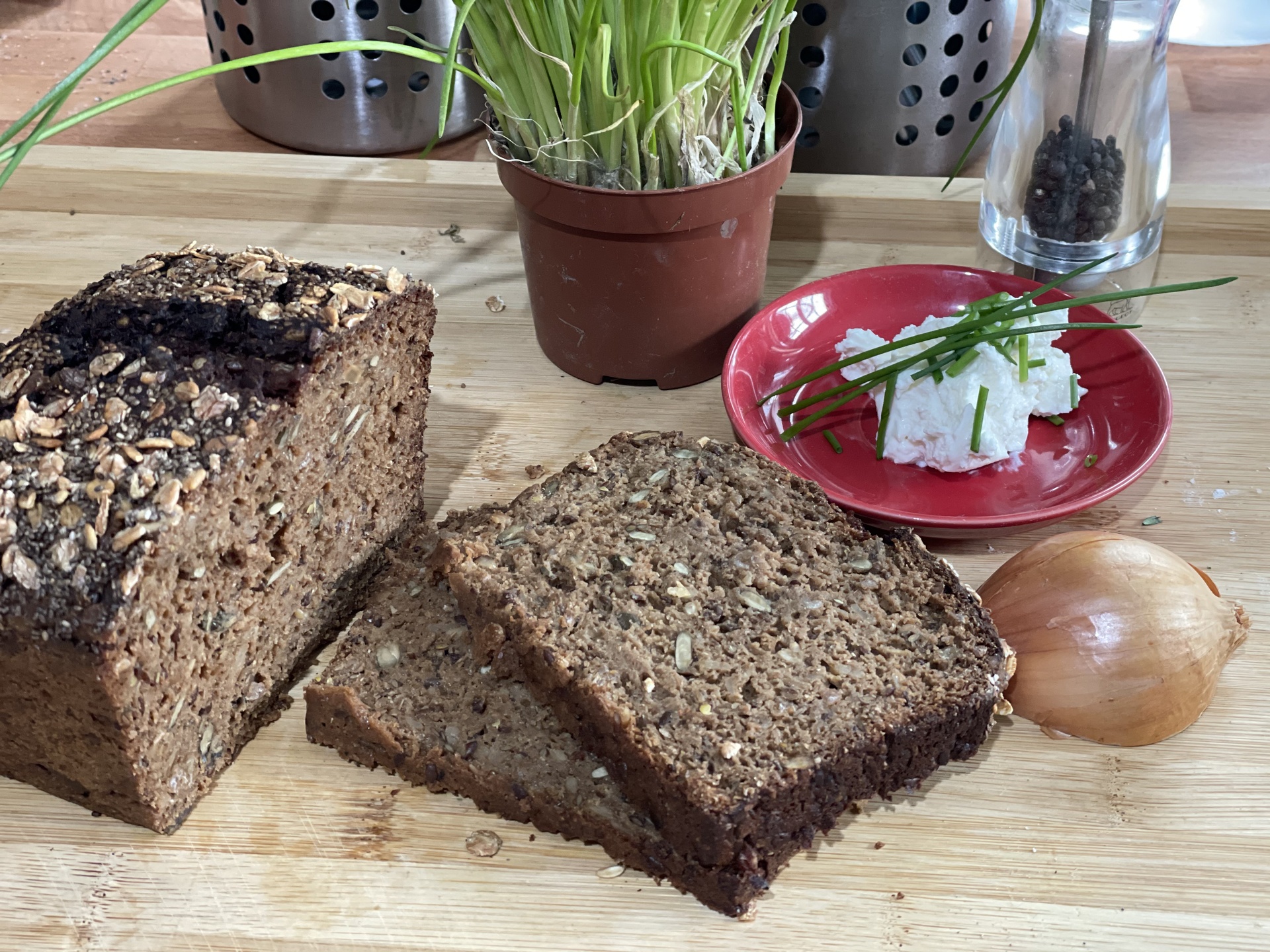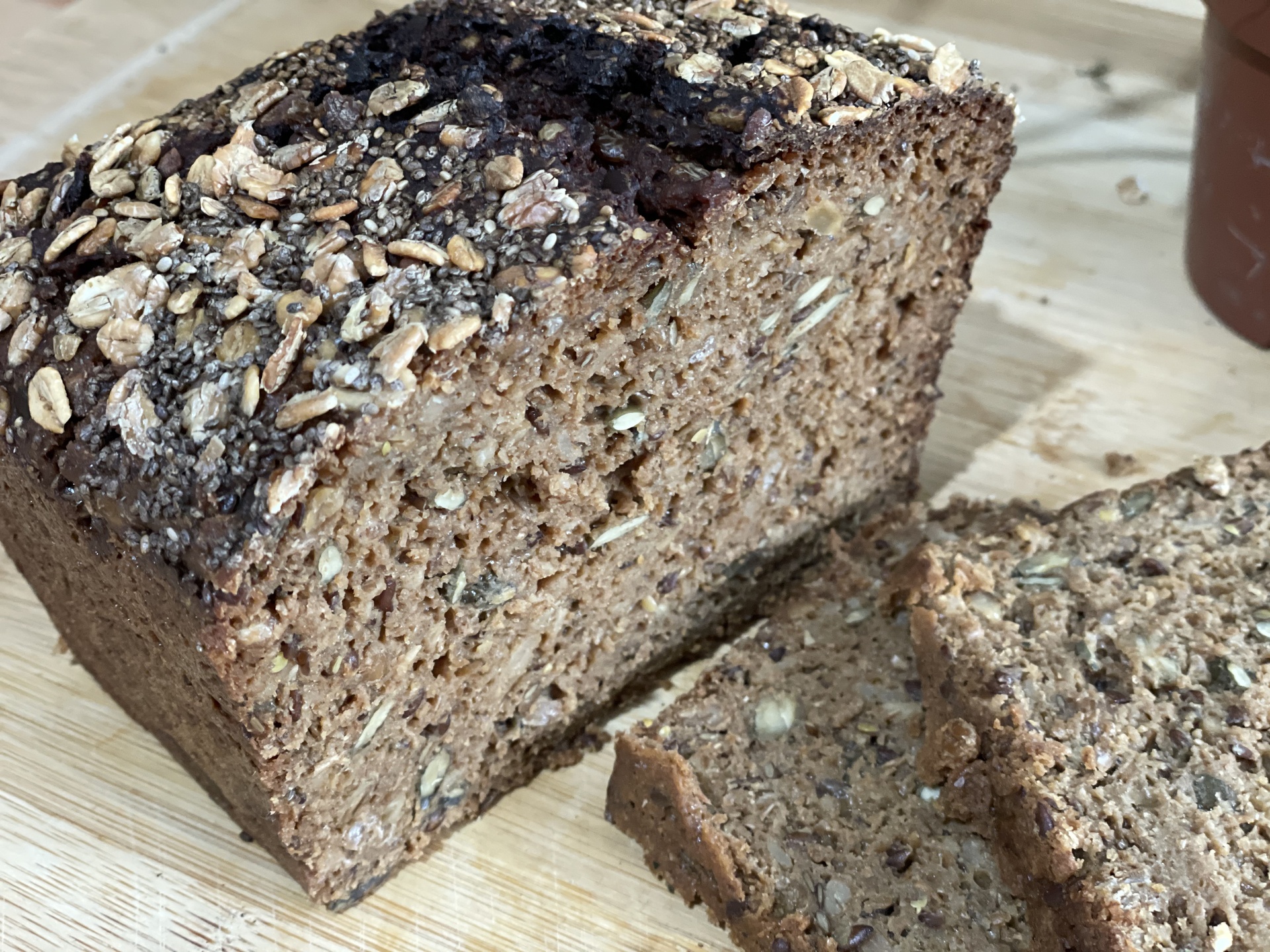Cologne-Style Black Bread
The succulent black bread of my hometown Cologne is one of the foods that I miss the most in Bulgaria. Fortunately, you can easily bake it at home, as long as you manage to dig up the ingredients (or suitable replacements). The ones that are hard to find in Bulgaria are dark molasses, buttermilk and rye grist.

Dark Molasses
Dark molassses is very popular as a sweet spread on fresh bread in Cologne. Outside of Germany, you may find "Grafschafter Goldsaft" or the organic variant by Alnatura.
It is a very thick, pitch black sweet syrup with a subtle vegetable note. What is mostly offered as "dark molasses" on the internet is usually not sweet but rather bitter and not suitable for bread. In Finland you can often find it as siiruppi (and the Finns also use it for dark bread).
It is not an optional ingredient but absolutely crucial for success. Not only does it give the dark color and the characteristic bittersweet note to Rheinisches Schwarzbrot (Rhineland black bread) but it is also responsible for the succulent texture. And its preservative effect also keeps the bread fresh for a longer time.
Buttermilk
Buttermilk is a side product of beating sour-cream to butter, see Home-made Sour Cream Butter. In Sofia it can be hard to find. You may be lucky finding buttermilk at the supermarket Hit). Short of buttermilk, you can also mix 400 g low-fat curd ("Quark") with 100 ml water. If nothing helps, replace the buttermilk with a rather liquid yoghurt. I have chosen the variant with curd and water this time.
Rye Grist
Rye grist is also not available on every corner. I could not find it at all this time and have replaced it with wholemeal flour. I therefore also added a little bit more liquid. After you have baken the bread two or three times, you get a feeling for the right consistence of the dough and you can easily vary the ingredients for improvisation.
Hot-soaked grains
When you want to bake grains in bread, you should never just add them dry to the dough. The seeds will later absorb water from the bread after it was baken, making it dry faster. I only add pumpkin seeds dry because I have the feeling that the soaking does not do them good in terms of taste.
That being said, you should always cook hard grains like rye, wheat or spelt until soft. Grains that are already soft and ready to eat should still be soaked in hot water for several hours. You should also add the necessary salt to the soaked grains, so that you avoid direct contact of the salt with the yeast or sourdough.
Caramel Coloring
Caramel coloring (also known as sugar color) does not contribute to the taste of the bread but only makes it dark. You can easily prepare it yourself: Caramelize 100 g sugar until very dark (there will be some smoke). Carefully add 50 ml very hot water and cook it for several minutes to a thick syrup. Attention! Risk of injury! The melted sugar can easily splash and may cause burns to unprotected parts of the body.
The caramel coloring is not sweet but rather bitter and should therefore be used in very small doses. You can keep it in a clean jar for several months.
Fun fact: It is not a coincidence that caramel coloring resembles a very popular and very sweet cold drink as it is the very same ingredient that gives the dark color to coke.
Ingredients
The ingredients are for a box-form baking tin of 3.8 l volume resulting in about 2.2 kg of bread.

Boiling Soaked Grains
- 90 g rye or wheat grains
- ca. 430 ml water
Hot Soaked Grains
- 90 g sunflower seeds
- 90 g grain flakes (oats, wheat, rye, spelt, ... you name it)
- 90 g flaxseed
- 300 ml water
- 1.5 tbsp salt
Dough
- 14 g dry yeast (oder 42 g fresh yeast dissolved in flour, sugar and water; let rest for 30 minutes).
- 300 g wholemeal rye flour
- 300 g wholemeal wheat flour
- 100 g wheat bran (or oat bran, rye bran, ...)
- 500 ml buttermilk (or 400 g low-fat curd dissolved in 100 ml water)
- 90 g pumpkin seeds
- 160 g (sweet!!!) dark molasses
- 1 tbsp dark maple syrup
- 1 splash of caramel coloring
- 200 ml water
- 1 tsp caraway seeds
- 1 tsp coriander seeds
- 3 capsules cardamom
Topping
- cereal flakes
- chia seeds (or ... whatever is at hand)
Preparation
- Cook the rye or wheat grains for 60 minutes in water until soft. Add the water in small portions as needed. An eventual surplus of water can be used for the dough.
- Scald the sunflower seeds, cereal grains, flaxseeds, and the salt with 300 ml boling water and let soak for at least 3 hours.
- Heat the oven to 230 °C (446 °F) without fan.
- Dissolve 160 ml dark molasses in 500 ml buttermil and 200 ml water (or in 400 g low-fat curd and 300 ml water), stir vigorously. Add the maple syrup and a splash of caramel coloring.
- Roast the coriander seeds, the caradamom capsules and caraway seeds in a dry coated pan. Crush in a mortar and remove the cardamom peel.
- Knead the flour, the wheat bran, the yeast, the pumpkin seeds, the spices, and the liquid for about 10 minutes to a very sticky dough. Alternative ingredients: Replace 100 g of the flour from the recipe with 100 g of rye grist. Knead the dough longer (30 minutes) and use 50-100 ml less water.
- Oil a box-shaped baking tin, add the dough and smooth the surface. The baking tin should be filled at most to half. If you use a smaller baking tin, reduce the baking time accordingly.
- Spray the surface of the bread with water and sprinkle with cereal grains and chia seeds. You can also use pumpkin seeds or grains but they will mostly fall off later, when you cut the bread.
- Let the loaf rest for 60 minutes covered with a kitchen towel until it has almost doubled in size.

- Place a heat-resistens cup or bowl filled with hot water in the oven.
- Notch the bread about 2 cm deep and transfer it to the center of the oven. Lower the temperature to 150 °C (302 °F) after closing the oven door.
- Bake the bread for 4 hours. Spray it with water every 30 minutes, so that the crust will not become too hard. Regularly check that there is still water in the vessel.
- Cover the bread with a kitchen towel when ready with baking. You should let it mature for at least two days in a bread box before cutting it. You can conveniently keep it in the freezer in small portions.

Leave a comment
Giving your email address is optional. But please keep in mind that you cannot get a notification about a response without a valid email address. The address will not be displayed with the comment!